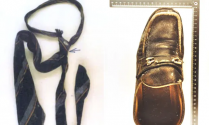I know it's not popular to suggest a person's ethnicity based on how they look but I agree that this gentlemen looks like he comes from the British Isles.
Do we know anything about what body part they used for the isotope analysis? There's no information about his teeth which is kind of odd, I think, since teeth and whether they had fillings, dental bridges, etc can sometimes give an indication as to where the work was done and when. Without the hair, which can really only give a historical blueprint up to about a year depending on the length of the hair then the isotope analysis had to be done on bone, teeth or both.
Using the age estimate of about 50 or born around 1947, he falls perfectly within the parameters of a whole wave of Brits who emigrated in droves in the 10 to 15 years after WW2 to search for a better life. People may not be aware that the UK was still rationing food well beyond 1945 and didn't end it until 1954. My family was one of those groups. My parents whittled down their choices between Canada, Australia, South Africa, the US and Kenya. We ended up in Canada but it seems this guy's parents may have decided on Australia.
I don't think the fact that he wore expensive shoes that were resoled and reheeled suggests they were secondhand. If anything based on the way he was dressed, it suggests that the money spent on bespoke shoes meant he appreciated the workmanship and comfort they provided to the point of ensuring years of comfortable wear. If so, he represents a huge portion of people who appreciate fine things and like to hang on to them.
His tie was definately meant for British origins market, whether in the UK, Canada, or Australia. Striped ties originated in England. The stripes were a means to identify a person's school background and are possibly related to heraldic images. Almost all ties made in Britain have the stripes going from the left shoulder to the right waist, whereas most American manufactured ties, the stripes go the other way. In prep schools in England the ties always went Right to Left. Supposedly, when students wore ties with the stripes going left/right, it denoted the fact they were the illegitimate children of a blue blood.
If he was 6 foot 5 inches and he weighed approximately 165 lbs or 75 kg, I can't see how an extra 12 pounds of weight would be instrumental in sinking the body. Divers usually have a rule of thumb regarding the weights they add to their dive belts which is about 10 percent of their body weight. Dive belts don't make a diver sink like a stone, they just counteract the natural bouyancy a person has, so putting an additional 12 pounds on this person wouldn't have made them sink. For contrast, when you hear about bodies tied to cement blocks, the average cement block weighs about 33 pounds.
I'd be interested to know whether the upper body trauma inflicted on this gentlemen could have been made by the metal shoe lasts. I can't see that being a really good clue, though, since they are the type of object that collectors would like to have. I would also like to know whether the lasts found tied to the body would be the size needed to make adjustments on this fellow's shoes.
The shoe lasts being tied to his belt are giving me vibes a la Virginia Woolf who filled her pockets with stones then walked in the river to drown herself.

 www.websleuths.com
www.websleuths.com

 www.websleuths.com
www.websleuths.com











